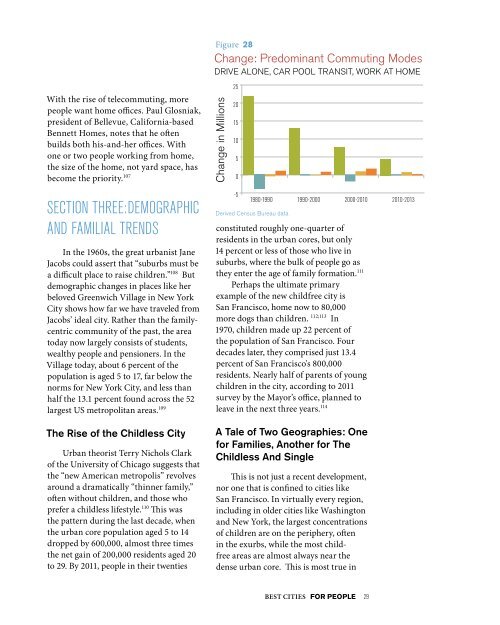FOR PEOPLE
1ONa2xt
1ONa2xt
Create successful ePaper yourself
Turn your PDF publications into a flip-book with our unique Google optimized e-Paper software.
With the rise of telecommuting, more<br />
people want home offices. Paul Glosniak,<br />
president of Bellevue, California-based<br />
Bennett Homes, notes that he often<br />
builds both his-and-her offices. With<br />
one or two people working from home,<br />
the size of the home, not yard space, has<br />
become the priority. 107<br />
SECTION THREE:DEMOGRAPHIC<br />
AND FAMILIAL TRENDS<br />
In the 1960s, the great urbanist Jane<br />
Jacobs could assert that “suburbs must be<br />
a difficult place to raise children.” 108 But<br />
demographic changes in places like her<br />
beloved Greenwich Village in New York<br />
City shows how far we have traveled from<br />
Jacobs’ ideal city. Rather than the familycentric<br />
community of the past, the area<br />
today now largely consists of students,<br />
wealthy people and pensioners. In the<br />
Village today, about 6 percent of the<br />
population is aged 5 to 17, far below the<br />
norms for New York City, and less than<br />
half the 13.1 percent found across the 52<br />
largest US metropolitan areas. 109<br />
The Rise of the Childless City<br />
Urban theorist Terry Nichols Clark<br />
of the University of Chicago suggests that<br />
the “new American metropolis” revolves<br />
around a dramatically “thinner family,”<br />
often without children, and those who<br />
prefer a childless lifestyle. 110 This was<br />
the pattern during the last decade, when<br />
the urban core population aged 5 to 14<br />
dropped by 600,000, almost three times<br />
the net gain of 200,000 residents aged 20<br />
to 29. By 2011, people in their twenties<br />
Figure 28<br />
Change: Predominant Commuting Modes<br />
DRIVE ALONE, CAR POOL TRANSIT, WORK AT HOME<br />
Change in Millions<br />
25<br />
20<br />
15<br />
10<br />
5<br />
0<br />
-5<br />
198199090<br />
1980-1990 1990-2000<br />
Derived Census Bureau data<br />
constituted roughly one-quarter of<br />
Figure 29<br />
residents in the urban cores, but only<br />
52 14 percent Major or Metropolitan less of those who Areas:2010<br />
live in<br />
16% suburbs, where the bulk of people 15.0%<br />
go as<br />
they enter the age of family formation. 111<br />
14.2%<br />
14%<br />
13%<br />
Perhaps the ultimate primary<br />
12%<br />
11.6%<br />
example of the new childfree city is<br />
10%<br />
San Francisco, home now to 80,000<br />
8%<br />
more dogs than children. 112;113 In<br />
6% 1970, children 5.3% made up 22 percent of<br />
4% the population of San Francisco. Four<br />
2%<br />
decades later, they comprised just 13.4<br />
percent of San Francisco's 800,000<br />
0%<br />
residents. Urban Core: Nearly Urban Core: half of parents of young<br />
CBD<br />
Inner Ring<br />
children in the city, according to 2011<br />
survey by Small<br />
the Mayor’s Areas (Zip<br />
office, Code<br />
planned Analysis<br />
to<br />
Zones)<br />
leave in the next three years. 114<br />
Early Suburb Later Suburb Exurb OVERALL<br />
Figure A Tale 34of Two Geographies: One<br />
Age for Families, 20-29 Share Another of Growth for The<br />
BY Childless FUNCTIONAL And SECTOR: Single 2000-2011<br />
This Earlier is Suburb not just a recent development,<br />
nor one that 14.3%<br />
Later Suburb<br />
is confined to cities like<br />
52.8%<br />
San Francisco. In virtually every region,<br />
Inner<br />
including<br />
Ring<br />
in older cities like Washington<br />
7.9%<br />
and New York, the largest concentrations<br />
CBD of children are on the periphery, often<br />
2.6% in the exurbs, while the most childfree<br />
areas are almost always near the<br />
dense Exurb urban core. This is most true in<br />
22.4%<br />
2000-2010 2010-2013<br />
13.5%<br />
BEST CITIES <strong>FOR</strong> <strong>PEOPLE</strong> 29<br />
Major Metropolitan Areas: City Sector




